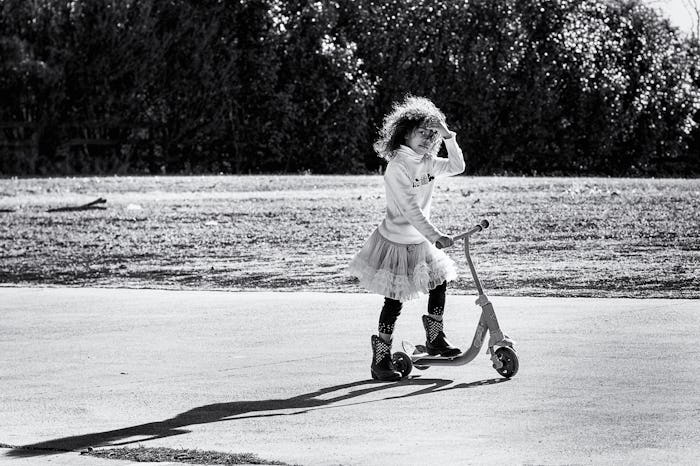Life

7 Subtle Ways Your Daughter Is Facing Sexism
There are a myriad of ways women face sexism, and the victims of this prejudice aren’t limited to 20-somethings and older. Young girls — your daughter, your cousin, your sister — deal with sexism daily, whether it comes in the form of a cat call or being told she can’t do something. These blatant forms of bigotry are obviously harmful, but there are also some subtle ways girls face sexism that are just as damaging. In fact, they may be more harmful, as they seep into the psyche over time and tear you apart.
This doesn’t mean you shouldn’t forget about the obvious ways girls face sexism — cat calls, being told what they can't do, pressure to meet the unrealistic and limiting images of what our culture considers to be beautiful — these are dangerous and damaging realities that women young and old battle on the regular. But beware the underhanded warfare that is taking place in schools, marketing, and social groups and perpetuating sexist mentality. The messages and language that come in this form can be very powerful and effective because of the indirect way in which it starts to take up residence in the subconscious.
Many parents with girls are already aware of the struggles they face when it comes to battling sexism in school, sports, and the workplace. But there are also subtle ways your daughter is facing sexism on a regular basis. These seven examples show how we might not realize just how much exposure to sexism out girls are dealing with.
1The Dress Code Myth
School dress codes have been a hot topic recently, and for good reason. For too long schools have mandated girls to dress in a way that will not "distract" other students (ie. males). In placing the responsibility on girls to cover there bodies so others can focus, schools make way for a litany of confusing messages about the female body. It tells girls that their body is not their own, which can open the floodgate for harmful actions against women such as abuse and rape.
2Labels
A friend who has two girls recently told me that her 8-year-old daughter being asked by peers if she was a "tomboy" or "girly girl." Even worse, she was being told she had to choose between the two archetypes. Her daughter — who says she considers herself a little bit of both — did not want to choose just one option, or only one group of girls to play with for that matter.
After mentioning this to some other friends, I discovered that this is a typica conversation, happening in social groups with girls as young as four years old. In forcing girls to choose between these arbitrary labels, people set a preseidnet for how girls shuld act and what their interests should be.
3Few Female Literary Heroes
An article on Everyday Feminism reported that girls are much more likely to be a sidekick than a main character in children's literature. This sends a dangerous message to both young male and female readers about who is in charge and who is just there for support. Althoug there are some empowering books for girls that feature a female main character, there is still work to do to close the gap.
4Messages About Beauty
Playing dress-up is normal and healthy part of childhood. But when the emphasis is geared toward beauty, thinness, and sexualizing the female body, things can start to go south. Psychology Today reported that participation in activities that focus on physical appearance can influence sel-esteem, body image and self-worth.
The images and marketing young girls are exposed to show a very small percentage of the body types and what is considered to be beautiful by cultural standards. It would be a shame for them to think there are only a few options of how to look.
5The Idea Of Family Or Career
There are so many women who have both a career and a family they love, but typically the emphasis is put on one thing over the other. It's important to girls to know that you can have both, if that's what you want. More and more women are starting to speak about how there is room in life for both career and family, and it's a great opportunity for girls to hear that life for them doesn't have to be whittle down to only one box to check.
6Antiquated Examples
It is a shame that certain characteristics, jobs, and roles are still assigned to only one gender. Both females and males are capable of a wide range of emotions and interests. Yet still, there are some unfortunate examples of strict gender roles that are outdated and giving our children the wrong message. The Guardian reported that even test questions on school tests can be filled with sexist stereotypes. Being exposed to this language over and over results in a subtle ingraining of these beliefs, which carry into adulthood.
7Toys For Girls
If a toy is considered to be traditionally "boy," there is typically a version of that toy marketed to girls. You will notice them as pink building blocks, tool sets with glittery handles, and soccer balls covered in peace signs and flowers. Although there is nothing wrong with making toys with different colors and decorations, it comes off as saying "it's OK for girls to use this now, because we've made it pretty." When, in reality, girls can play with whatever toys they want. And the same goes for boys.
Images: Jason Devaun, Photocapy, Jamie Schapp, Sean, Luci Correia, Kevin Dooley, Liga Eglite, Bill Ward/ Flickr